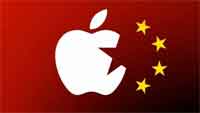| |
|
| |
|
 |
Supply
Chain by the Numbers |
| |
|
| |
- March 29, 2018 -
|
| |
|
| |
|
| |
|
| |
Truck Driver Pay is Up, but not Much; Value of Warehouse Space is Soaring; DHL Jumps Back into US Domestic Parcel Business; Apple using a Lot more China Suppliers |
| |
|
| |
| |
| |
$53,000 |
 |
That is the median level of annual pay (wages only) of US long truck drivers, according to the just released Driver Compensation Study from the American Trucking Associations. That is up about 15% over the last such study, conducted in 2013. The study was based on survey responses from more than 100,000 drivers. The news for drivers at private fleets was even better, with annual wages jumping 18% to $86,000 per year. Bob Costello, ATA chief economist, notes in the report that fleets were offering drivers signing bonuses and attractive benefits packages in an effort to recruit and retain them. SCDigest will note that some larger carriers are clearly paying much more than the $53,000 annual wage level. Still, 15% growth over the 5 year horizon means average annual increases of less than 3% - hardly enough to stem the growing driver shortage, and in the face of some calls that driver pay needs to rise to more than $70,000 to have a real impact. The problem: shippers don't want to pay the significant increase in rates such a market clearing wage would require. And the beat goes on.
|
|
|
| |
| |
|
|
|
That's how many years it has been since German parcel carrier DHL, a unit of giant Deutsche Post, left the US domestic parcel market after buying Airborne Express and losing billions of dollars here, though it continued to support cross border deliveries. But guess what: "They're back." DHL has just announced it is – what else – jumping on the ecommerce bandwagon for urban deliveries. The company has released a same-day and next-day delivery service for online retailers, branded as Parcel Metro, comprised of a network of local and regional delivery vendors and crowd-sourced drivers and vehicles designed for last-mile deliveries. DHL has already started operating the service in Chicago, Los Angeles and New York, and plans to expand to Atlanta and Dallas in the second quarter, San Francisco in the third, and Washington, D.C., later this year. DHL says its software platform allows it to find the best drivers for each route. Customers can choose from several delivery time windows, including two-hour, same day and next day, as well as their preferred delivery address. Retailers can also customize the mobile interface with their own branding. We say "welcome back."
|
| |
| |
|
| |
| |
$2.5 Billion |

Source: Cult of Mac |
That is the percent of Apple suppliers related to its hardware products (parts and assembly operations) that are Chinese, either from the mainland or from now China-ruled Hong Kong. Apple disclosed a list this month that showed its China mainland-based suppliers surged to 27, up from only 19 in 2017, according to analysis this week by the Nikkei Asian Review. That number has almost quadrupled in the past six years. The actual spend by supplier was of course not revealed, so it is not known the percent of supplier procurement dollars by country. B comparison, the number of US-based suppliers in the list of about 200 companies fell to 39 from 43 in 2017. Given that China now represents about 20% of Apple revenue, and most Apple manufacturing and assembly operations are performed in China, "Whether Apple is under any pressure to buy more components from Chinese makers is unclear," the Nikkei Asian Review noted. Chinese homegrown national champions that appeared for the first time on Apple's supplier list included BOE Technology Group, the country's top display maker; Jiangsu Changjiang Electronics Technology, the nation's No. 1 chip packaging and testing company and O-film Technology that Apple CEO Cook visited during his last trip to China in December. |
| |
| |
|
|
|
| |
 |
 |
| |
|
|
| |